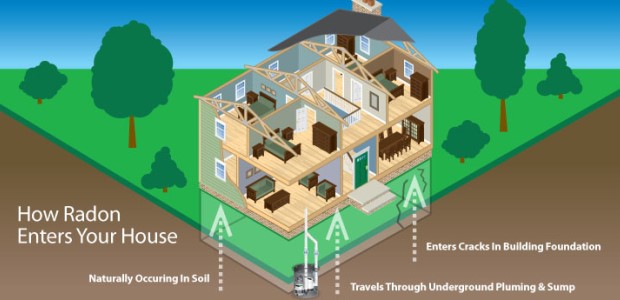
Eliminating Radioactive Gas in the Home and Workplace
During the month of January, EPA wants to raise radon awareness among homeowners and business owners.
- By Jordy Byrd
- Jan 06, 2015
A silent killer lurks underground. Radon, a naturally occurring gas, cannot be seen, tasted, or smelled—yet it kills 21,000 people from lung cancer in the United States each year.
The radioactive gas is released in rock, soil, and water and can build up to create dangerous levels inside homes and work places. The Environmental Protection Agency has designated January "Radon Action Month" since 1999 in an effort to raise awareness and encourage businesses and homeowners with the tools to get tested. "Exposure to radon is the main cause of lung cancer for neversmokers and the second leading cause for the general population after smoking," wrote Philip Jalbert, communications director with EPA's Indoor Environments Division. "Homes with an elevated level of radon at or above EPA's action level of 4pCi/l, have been found in every state. It's important to note that there is no known 'safe' level of radon; radon at a level below 4pCi/L still poses a risk."
EPA and the World Health Organization have developed radon risk management policies to ensure proper testing and mitigation services, and encourage businesses and homeowners to contact a state radon program for individualized resources and support.
"The potential for radon is, and can be, a localized phenomenon; primarily due to local geology," said Brett Sherry, program manager with Oregon Health Authority, Oregon's radon program. "There is no reliable way to predict the radon concentration in a building prior to construction."
Various methods can be used to lower radon levels. Basic prevention includes sealing cracks and other openings in building foundations or covering sump pump holes in water basins. Aggressive HVAC systems, subslab, drain tile, and block wall suction methods also are used but are not proven to consistently lower radon levels in buildings. The most effective radon mitigation technique is a subslab depressurization system. It uses a series of pipes to collect the radon before it enters the building and is then funneled outdoors.
According to EPA, system description labels must be placed on all mitigation systems on the electric service entrance panel, or other prominent location.
Ensure pipes are properly labeled as hazardous material and develop a pipe marking system to ensure continued air quality. Radon labels must be legible from a distance of at least 3 feet and include the following information:
"Radon Reduction System, the installer's name, phone number, RCP Identification Number, date of installation, and an advisory that the building should be tested for radon at least every two years or as required or recommended by state or local agencies."
All exposed and visible interior radon system vent piping sections must be identified with at least one label per floor that identifies the pipe as part of the radon reduction system. Appropriate labels include "Radon Reduction System," "Radon System Pipe," "Component of Radon Reduction System," or "Radon Pipe."
Despite the toxicity of radon, the goal of National Radon Action Month isn't to cause hysteria, Sherry said. "We've had people call in in tears, usually not on their own behalf but for their children," he added. "You can't go back in time and remove that exposure, but you can prevent further exposure."
EPA encourages homeowners and businesses to undergo an initial radon test before contracting a professional radon mitigator:
Step 1: Take a short-term radon test. There are various radon test kits that use activated carbon, charcoal liquid scintillation, or ionization chambers to absorb and measure radon. You can purchase a $15 short-term radon test kit from the American Lung Association here.
Step 2: If your result is 4 pCi/L or higher, take another short-term test. If the average of both tests is above 4 pCi/L, or the result of your long-term
test is above 4 pCi/L, contact a radon mitigation service provider to eradicate the problem. If your test results are below the action level of 4 pCi/L, retest within six months.
For more information, visit Epa.gov/radon or contact the National Radon Program Services hotline at 1-800-SOS-RADON.